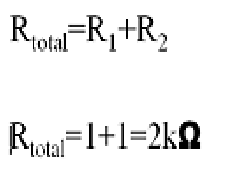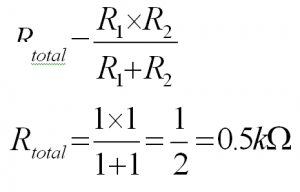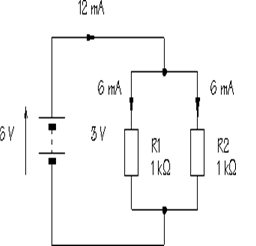- The flow of electric current through a conductor experiences a certain amount of resistance
- The resistance, expressed in ohms (, named after George ohm), kilo-ohms (k, 1000), or mega-ohms (M, 106) is a measure of how much a resistor resists the flow of electricity.
- The magnitude of resistance is dictated by the electric properties of the material and material geometry.
- This behavior of materials is often used to control/limit electric current flow in circuits.
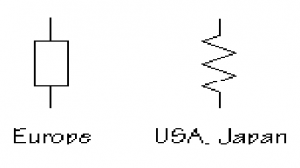
Henceforth, the conductors that exhibit the property of resisting current flow are called resistors.
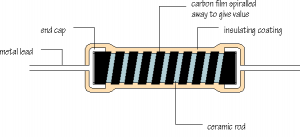
A resistor is a dissipative element. It converts electrical energy into heat energy. It is analogous to the viscous friction element mechanical system.
- When electrons enter at one end of a resistor, some of the electrons collide with atoms within the resistor. These atoms start vibrating and transfer their energy to neighboring air molecules. In this way, a resistor dissipates electrical energy into heat energy.
- Resistors can be thought of as analogous to water-carrying pipes. Water is supplied to your home in large pipes, however, the pipes get smaller as the water reaches the final user. The pipe size limits the water flow to what you actually need.
- Electricity works in a similar manner, except that wires have so little resistance that they would have to be very very thin to limit the flow of electricity. Such thin wire would be hard to handle and break easily.
Resistors-Water Analogy


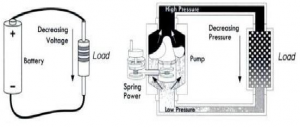
Resistor V-I Characteristic
- In a typical resistor, a conducting element displays a linear voltage-current relationship. (i.e., the current through a resistor is directly proportional to the voltage across it).
I α V
- Using G as a constant of proportionality, we obtain:
I = GV
- Equivalently,
where R = 1/G.
V = RI (or V = IR)
- R is termed as the resistance of conductor (Ω, ohm)
- G is termed as the conductance of conductor (ʊ, mho)
Resistor Applications
- Resistors are used for:
- Limiting current in electric circuits.
- Lowering voltage levels in electric circuits (using voltage divider).
- As current provider. As a sensor (e.g., photoresistor detects a light condition, thermistor detects temperature condition, strain gauge detects load condition, etc.)
- In electronic circuits, resistors are used as pull-up and pull-down elements to avoid floating signal levels.
Resistors: Power Rating and Composition
It is very important to be aware of the power rating of resistors used in circuits and to make sure that this limit is not violated. A higher power rating resistor can dissipate more energy than a lower power rating resistor.
Resistors can be made of:
- Carbon film (decomposition of carbon film on a ceramic core).
- Carbon composition (carbon powder and glue-like binder).
- Metal oxide (ceramic core coated with metal oxide).
- Precision metal film.
- High power wire-wound.
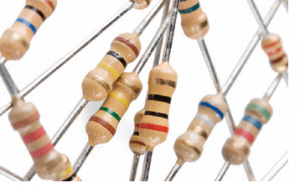
Types of Resistors
Different types of resistors are used in practical electrical and electronic circuits. Resistors can be classified as follows:

Different Types of Resistors
- Wire wound resistors
- Pencil resistors
- Metal film resistors
- Variable resistors
- Thick and thin-film resistors
- Network and surface mount resistors
- Special resistors (Light Dependent Resistor)
Resistor Labels
- Wire-wound resistors have a label indicating resistance and power ratings.
- A majority of resistors have color bars to indicate their resistance magnitude.
- There are usually 4 to 6 bands of color on a resistor. As shown in the figure below, the rightmost color bar indicates the resistor reliability, however, some resistors use this bar to indicate the tolerance. The color bar immediately left to the tolerance bar (C), indicates the multipliers (in tens). To the left of the multiplier, bar are the digits, starting from the last digit to the first digit

Resistor value =AB x10 ^ C ± tol%( Ω)
Resistor Colour Codes
|
| Band color | Digit | Multiplier |
| Black | 0 | X1 |
| Brown | 1 | X10 |
| Red | 2 | X100 |
| Orange | 3 | X1000 |
| Yellow | 4 | X10000 |
| Green | 5 | X100000 |
| Blue | 6 | X1000000 |
| Purple | 7 | X10000000 |
| Grey | 8 | X100000000 |
| White | 9 | X1000000000 |
| Silver | – | x.01 |
| Gold | – | x.1 |
Example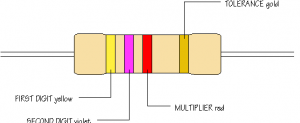
- The first band is yellow, so the first digit is 4
- The second band is violet, so the second digit is 7
- The third band is red, so the multiplier is 102
- The resistor value is 47 x10^2 ± 5%( Ω)
Metric Units and Conversions
| Abbreviation | Means | Multiplyunit by |
Or |
| p | pico | .000000000001 | 10^-12 |
| n | nano | .000000001 | 10^-9 |
| µ | micro | .000001 | 10^-6 |
| m | milli | .001 | 10^-3 |
| . | Unit | 1 | 10 |
| k | kilo | 1,000 | 10^3 |
| M | Mega | 1,000,000 | 10^6 |
| G | Giga | 1,000,000,000 | 10^9 |


